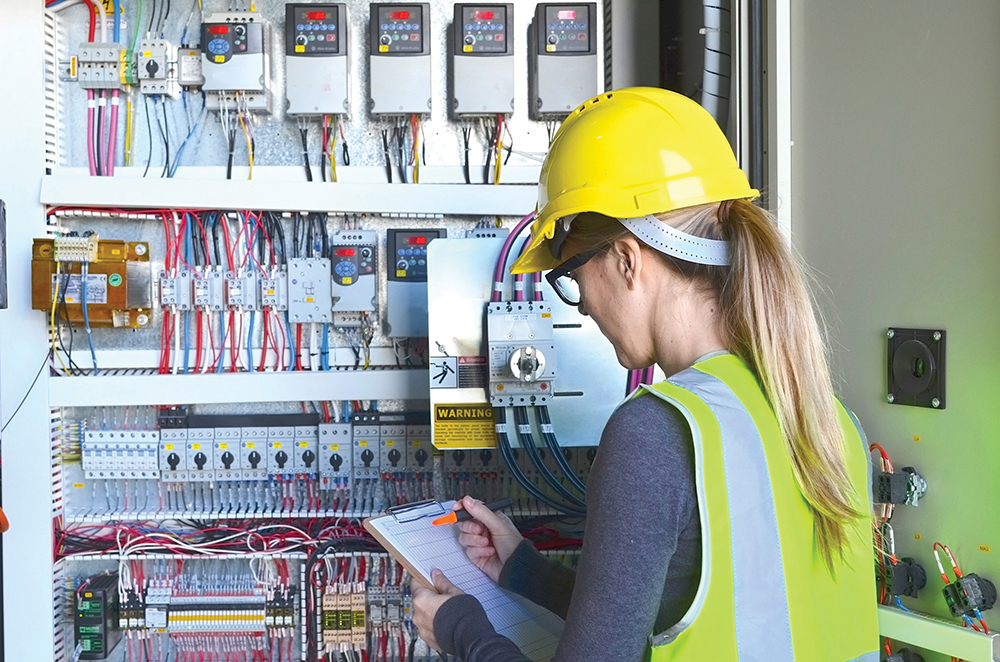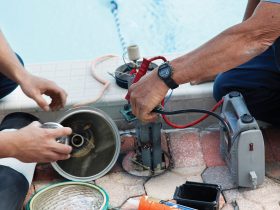When a building or structure is supplied with electrical power, the equipment and conductors at the point of delivery to the premises are defined by the National Electrical Code as the service. This definition reads: “Service. The conductors and equipment for delivering electric energy from the serving utility to the wiring system of the premises served.”1
The electrical service for a building or structure can be thought of as the “”heart beat”” of the electrical system for the property. We depend on the electrical service to function every day without fail, and it seems as though we take the power for granted until there is an outage. During times of power failures, we realize how dependant we have become on electricity in our everyday lives.

Photo 1. Single service disconnect

Figure 1. Service point located at point of attachment
The electrical service can be small or very large in capacity based on the needs of the building or occupancy served. Whether the service is large or small, there are common elements involved in making an electrical inspection. This article will focus on inspections for electrical services and emphasize the major areas one should verify for compliance with the minimum provisions in the NEC. It should be noted that this article is not inclusive of every element for all cases. Each electrical service may have specific features or characteristics that may require application of additional rules contained in the NEC or other standards. The authority having jurisdiction has the responsibility and authority for the final approval, as indicated in 90.4, for electrical services.
In recent years, it seems as though there has been more and more privatization in the circle of electrical utility power. The NEC includes the term service point, which is defined as: “Service Point. The point of connection between the facilities of the serving utility and the premises wiring.”2
Having an understanding of this definition is a good starting point. First one must determine where the utility company stops having responsibility and regulation and the customer and NEC start having responsibility and regulation. At that point is where the NEC is required to be applied to the premises wiring. An example is at a simple weather head for a dwelling unit service; typically the serving utility company will provide a service drop to connect to the service conductors at this weather head. This is generally the service point for this particular situation (see figure 1).
The rules in the NEC must apply to all electrical conductors and equipment beyond this connection at the service point, unless there are local provisions or codes that regulate the installation. Recent trends find the service point becoming a moving target, and it is ending up further and further down the street. The NEC is, as a result, also seeing the incorporation of new over-600-volt requirements in the Code that must be applied to premises wiring systems falling under the scope of 90.2.
Location
When approaching the service for an inspection, one of the first observations that is made is the location. The Code requires, generally, that each building be supplied by one service, although additional services may be permitted by the AHJ under certain specific conditions (see 230.2).
Service Disconnecting Means
After verifying the location of the service disconnect, it is important to verify that the equipment is “suitable for use as service equipment” or “suitable for use only as service equipment.” This marking is required to indicate such suitability and is related to some specific characteristics that the equipment must incorporate such as short-circuit current ratings, grounding and bonding provisions, and either a single main disconnect, or not more that six installed in the assembly (see photos 1 and 2).

Figure 2. Manufacturers series combinations markings on equipment
Equipment marked “suitable for use only as service equipment” is permitted to be used only in that position, whereas equipment marked “suitable for use as service equipment” would be permitted to be installed in the service position or the feeder position when appropriate grounding and bonding connections are made. It should also be noted that the definition of disconnecting means in Article 100 indicates that it can be a single device, or group of devices, by which the electricity can be disconnected. The rules in 230.71(A) get a bit more specific and require a limit of six disconnecting means and where the six are provided individually they must be grouped in the same location. The intent is to give the occupant or emergency response personnel the ability to remove the electricity from one location. Here again, the grouping does not include maximum distances between the service disconnects, and meeting the intent of the section is a decision the inspector must make. The key is to ask the question “What is the rule trying to accomplish from a safety perspective?” If it starts to be questionable, then further consideration is warranted.
Identification
Each service disconnect must not only indicate the load served in accordance with 110.22, but a single service disconnect or each of the two through six permitted by 230.71 must be identified specifically as a service disconnect. Manufacturers often provide suitable labels for this purpose with equipment that is suitable for use as service equipment.
Short-Circuit Current Ratings
The equipment must be suitable for the available short-circuit current at the line terminals of the service (see 110.9 and 110.10). This is another marking requirement of the manufacturer.

Photo 2. Six service disconnects
It is important that the inspector and installer ensure that the service equipment is applied within its marked ratings, voltage, ampacity, hertz, and short-circuit current ratings. It may include a marking such as “suitable for use on a circuit capable of delivering not more than 30,000 amperes.” The marking may also indicate that the short-circuit current rating of the equipment is equal to the lowest rated device installed. If a panelboard rated at 30,000 short-circuit amperes has breakers rated at 30,000 amperes and one breaker rated at 10,000 short-circuit amperes, for example, the equipment short-circuit rating will default to the 10,000 ampere rating. Another example is when fusible switches are used as the service disconnect in a service switchboard. If the equipment is suitable for 65,000 short-circuit amperes, in order to maintain the short-circuit current ratings the fuses must also have a short-circuit current rating greater than the rating of the service switchboard. If a fuse with a 10,000-ampere short-circuit current rating is installed in the service, the rating of the service defaults to a 10,000-ampere short-circuit current rating. It is, therefore, critical to verify the short-circuit current rating of the service equipment.
Series-Rated Overcurrent Protective Devices

Figure 3. Motor contribution exceeding 1 percent allowance of 240.86(B)
Services often employ overcurrent devices applied in series-rated combinations. The suitable and tested combinations are required to be marked on the end use equipment by the manufacturer (see figure 2).
This is a critical part of an inspection of a service relative to maintaining an adequate short-circuit current rating. Inspectors need to verify that the combinations are in accordance with the manufacturers’ markings and the appropriate field warning labels have been applied as required by 110.22. They also need to be careful of any motors that are installed between overcurrent devices applied in series combinations. If the mount of motor current loads installed between the devices applied in a series combination exceeds one percent of the short-circuit current rating of the lower rated device in the end use equipment, the series ratings are not permitted. See 110.9, 110.22, and 240.86 for the rules relative to overcurrent devices applied in series-rated combinations (see figure 3).
Grounding and Bonding Connections
Grounding and bonding connections in the service equipment are a critical element of a service inspection. For the proper overcurrent device operation, the grounding and bonding connections at the service must be verified.
For a typical grounded system terminating in a service disconnect, there are four conductors that must be connected together at the service disconnect. Think of this as the grounding and bonding target. The four conductors that must come together in the service equipment are (1) grounded conductor; (2) main bonding jumper; (3) grounding electrode conductor; (4) equipment grounding conductor.

Figure 4. Neutral disconnect required by 230.75
For grounded systems, the NEC specifies the grounding requirements in the service disconnect. The grounded conductor is required to be routed with the service conductors and bonded to the service disconnect enclosure [see 250.24(B)]. This brings two of the previously mentioned conductors together—main bonding jumper and the grounded conductor. Section 230.75 indicates that a means to disconnect the grounded (usually the neutral) conductor must be provided in the service equipment and it can be a terminal. This is usually labeled as the “Neutral Disconnect Link.” Verify that even with the neutral disconnect link removed that the grounded conductor remains grounded (see figure 4). This involves verifying the connection points for the main bonding jumper.
It should be pointed out that the grounding electrode conductor is permitted to be terminated on equipment grounding terminal bar to which the main bonding jumper is connected. This is usually the case in larger electrical service equipment. The next item that must connect to this point is the grounding electrode conductor. The Code requires this connection also to be made to the grounded service conductor. Generally this is done in the service disconnect because of the listing and installation requirements for the equipment. The last conductor that will be connected to this target point in the service disconnect is the equipment grounding conductor(s) from the feeder(s). Note there may be more than one equipment grounding conductor, as there is generally more than one feeder.
The inspection must also include verification of the grounding electrode(s) or grounding electrode system in accordance with the provisions of Part III of Article 250. Section 250.50 requires that if any of the electrodes that are permitted for grounding in 250.52(A) are available on the premises at the building served, they are required to be used as the grounding electrode for the service. It is important that a single electrode or a group of electrodes bonded together to form the grounding electrode system be connected to the service grounded conductor at the service. Separate electrodes that are bonded together are considered as one by 250.58. This is even more critical where there is more than one service installed on a single building. The grounding electrode conductor sizing must be verified to comply with 250.66 and Table 250.66. The grounding electrode conductor must also meet the installation requirements of 250.64. This includes protection from physical damage, installation in a continuous length without splices or joints, and protection from magnetic fields when installed in metal raceways. The connection of the grounding electrode conductor to the electrode must meet the provisions of 250.10 for protection from physical damage. It also is required to be accessible generally, but an exception relaxes this requirement for buried or encased electrodes. The connection should be made with a device suitable for the purpose and conditions.

Photo 3. Bonding in accordance with 250.92(B)(4)
Metal raceways or enclosures for service-entrance conductors must be bonded in a manner specified by 250.92(A) and (B). The basic concept here is that this bonding should be heavier than what is required on the downstream side of an overcurrent device (see photo 3).
Usually, the only overcurrent protection on the supply side of the service is the overcurrent device on the primary side of the service transformer. This bonding must be stout enough to endure faults until this device can clear. Bonding jumpers and equipment grounding conductors on the downstream side of overcurrent devices are sized, at a minimum, in accordance with 250.122 and Table 250.122.
The Code also requires bonding of electrically conductive materials such as metal water piping systems and other metal piping systems. There is a requirement for bonding structural steel that is interconnected to form a building frame and where likely to become energized. See 250.90 and 250.104 for the specifics. Detailed information about grounding and bonding of electrical services can be found in the Soares Book on Grounding, 8th Edition.
Capacity
Overcurrent Protection
Another element of the service inspection includes a look at the feeder and branch-circuit overcurrent devices and the connected conductors to ensure they are protected against overcurrent. These devices are required to be sized at not less than the noncontinuous load plus 125 percent of the continuous load in accordance with 210.19(A) and 215.2(A). Exceptions to both of these requirements are where 100 percent rated devices and equipment are installed. This may involve verification to a blueprint/panel schedule or the AHJ may have to verify this through the provisions of 215.5. Section 215.5 indicates that the AHJ can request a diagram of the feeders and loading to ensure adequate capacity. The feeder and branch-circuit overcurrent devices and disconnects must be marked to indicate the load served. The overcurrent protection requirements for conductors are located in 240.4.
Points of Connection

Figure 5. Safeguards per 450.27 where installation presents fire hazard
Other related elements of inspections of services that one may have to consider are overhead service drops, the point of attachment, and the minimum clearance above ground. If there is an underground lateral from an oil-filled transformer, the burial depth, routing, and protection from physical damage are a few items for consideration. Another major concern addressed in general fashion in 450.27 is taking the proper precautions based on the location of an oil-filled transformer (see figure 5). Even though the serving utility often has jurisdiction, the location can have an impact on building and personnel safety. Good communication and coordination in this situation is always the best approach.
Summary
Electrical service inspections relate critically to the safety of persons and property. Sometimes inspectors take the “heart beat” of the electrical system for granted by inspecting electrical services in a routine fashion. It is difficult to put in a single writing every element that one should consider and verify when making an electrical safety inspection of a service. Each service and installation is based on specific purposes or conditions for use and must be inspected on an individual basis. Always consult the local authority having jurisdiction for any local amendments or requirements.
1 NFPA 70,National Electrical Code2002, Article 100, (National Fire Protection Association, Quincy, MA, 2002), p. 70-38.
2 NFPA 70, Article 100, p. 70-38.










Find Us on Socials